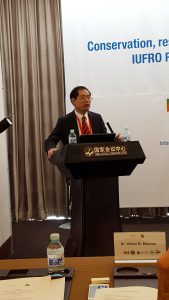
Lu Wen Ming delivering welcome remarks at the dryland session. Photo: Gerda Wolfrum, IUFRO Headquarters
Session A-05(108): Conservation, restoration and sustainable use of dryland ecosystems
There is clear evidence of the fact that the growth rate of CO2 concentration has been increasing and, together with other greenhouse gases, this increase is a main driver of global warming. Unfortunately, these gases have a relatively long lifetime – CO2, for example, has a lifetime of 200-400 years – which means that we are putting a heavy burden on future generations.
Desertification is one of the results of rising temperatures. In China there are actually 4.52 million km2 of drylands constituting 47.1% of the total landmass. Parts of these dryland areas are threatened by degradation and desertification. In Mongolia we are witnessing a marked decrease of the number and area of lakes. This is mainly due to human activities such as coal extraction and irrigation. These and other anthropogenic drivers of change in drylands intensify the pressure on land, which leads to land degradation and decreases the ecosystem value, thus affecting people’s livelihoods.
Consequently, it is vital to conserve the soil and biodiversity of drylands as they are natural capital which generates ecosystem services. It is important to understand that natural ecosystems provide regulating services to cultivated ecosystems, such as water, soil erosion, climate, pollination etc. The sustainability of cultivated ecosystems is only possible if the remaining natural ecosystem is able to secure these regulating services.
Restoration of degraded land is one major option of dealing with this complex problem. For example, in the Near and Middle East there has been agriculture for 10,000 years, but now this very zone is one of the hotspots of desertification. This tells us that in this area we have witnessed a great loss of dryland productivity. This is also the case in other parts of the world. Restoring what is already degraded may succeed, but it is an expensive effort. And yet, we must not give up land with a potential productivity, and we should strive towards increasing the amount of productive land.
Invited keynotes:
Prof. Pak Sum Low (Malaysia): Climate Change and Dryland Ecosystems
Prof. Uriel Nahum Safriel (Israel): Conservation, restoration and sustainable use of dryland ecosystems
Mr. You Lin Yang (China): Land Degradation Neutrality Target Setting Programme (LDN TSP) – Priority Area to Implement the UNCCD
Presentations of research and case studies from the region:
Dr. Ya Juan Zhu (China): Water use strategy of two willow in semi-arid alpine sandy land, Tibetan Plateau
Dr. Ki-hyung Park (Korea): Comparison of windbreak effect and installation cost of sand barriers on sandy land in China
Mr. Zeng Ming Song (China): Sustainable and climate-resilient land management in Western PRC – achievements and prospects of the GEF-PRC partnership on Land Degradation
Dr. Jino Kwon (Korea): Effect of forest stands (Azadirachataindica) on soil water contents during rainfall: a case study in the central dry zone of Myanmar
Welcome remarks by
Mr. Jian Liu, UNEP-IEMP
Prof. Wen Ming Lu, CAF, China
Prof. Park Jung Hwan, NIFoS, Korea

Leave a Reply